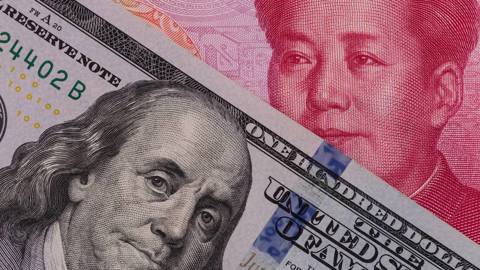China has run into major road blocks as it has attempted to implement its "dual circulation" growth strategy. Its success in managing the challenges it faces could be the difference between a global recovery and a global recession.
HONG KONG – China’s growth model is undergoing fundamental change. After decades of relying primarily on external demand to drive growth, the government has embraced a “dual circulation” model, driven by both internal and external demand. The goal is to make China’s economy more resilient and less vulnerable to external shocks, but the structural transformation has run up against major roadblocks.
When Deng Xiaoping launched his “reform and opening up” in 1978, China pursued a development strategy modeled after successful East Asian economies like Japan and South Korea: welcome foreign direct investment, expand cross-border trade linkages, leverage low labor costs to bolster the manufacturing sector, and take advantage of external demand to drive growth. Over the last four decades, FDI flows – about two-thirds of which came through Hong Kong – enabled China to transform Guangdong and other coastal provinces into global supply-chain hubs.
As industrialization progressed, incomes and wealth increased, and Chinese workers became consumers of both goods and services. As a result, the foreign-trade-to-GDP ratio declined, from a peak of 67% in 2006 to around 35% today, though China still relies on the jobs provided by its export industries.
As China built up its manufacturing sector, it also invested heavily in expanding its construction and financial industries, thereby laying the foundations for a dynamic real-estate market. Over the last decade, the nominal average annual growth rate of the construction sector and the financial and real-estate industries reached 13%, 14.8%, and 10.5%, respectively.
In 2021, China’s construction sector contributed 13.8% to China’s GDP, with the real-estate industry’s value-added reaching 6.8% of GDP, though it fell to 6.1% in 2022. Today, real-estate assets account for about 70% of household wealth, with important implications for consumption. Moreover, real-estate loans account for 27% of total bank credit, meaning a thriving real-estate market is also critical to financial stability.
The real-estate market’s rapid growth was driven partly by a financing innovation that originated in Hong Kong. Rather than completing projects, and then recouping their investment, residential housing developers began selling units before completion. This enabled them to use down-payments from home-buyers – in addition to the funds released by lending institutions as construction progressed (construction drawdowns) – to finance projects. From 2015 to 2022, the share of down payments and mortgages in total developer funding increased from 62.4% to 80.4%.
But this approach carried risks. By striking deals before construction was completed, developers and home-buyers left themselves exposed to interest-rate increases and slowdowns in price growth.
Developers who had borrowed heavily using US dollar bonds were particularly vulnerable – a reality that became painfully clear when surging inflation in the United States compelled the Federal Reserve to begin aggressively raising interest rates. Last year brought a series of defaults by major real-estate developers, which forced local governments to intervene to protect the rights of the affected home-buyers.
The real-estate sector’s travails have generated considerable fiscal challenges. In 2021, direct real-estate taxes accounted for 16.9% of national tax revenue, and 24% of local-government tax revenue. But falling real-estate prices have squeezed those revenues. In 2022, income from state-owned land sales decreased by 23.2%, causing China’s national budget revenue to fall by 20.6%. Declining revenue is also undermining local governments’ ability to support growth, such as by financing urban investment platforms.
The deterioration of US-China relations, and the disruptions caused by the COVID-19 pandemic, have further impeded China’s structural transformation. In fact, the economy’s internal and external circulation have both slowed significantly, damaging the balance sheets of households, enterprises, and all levels of government.
Both imports and exports fell last month, by 4.5% and 7.5%, respectively. Within China, jobs are not being created fast enough to absorb the supply of new graduates: as of last month, some six million young people (aged 16-24) – 20.8% – were unemployed. Housing and stock prices remain under pressure.
But there is reason to hope that China will bounce back from its current struggles. US Secretary of State Antony Blinken’s recent visit to China may augur stabilization of the US-China relationship – or, at least, a respite from further deterioration.
In any case, China’s government is committed to stimulating employment, stabilizing the housing sector, managing financial risks, supporting technological innovation, and encouraging green and inclusive growth. The market seems to be anticipating a comprehensive and forceful stimulus package that supports these objectives.
The rest of the world has an obvious stake in the outcome. China’s success in managing the challenges ahead could be the difference between a global recovery and a global recession.











HONG KONG – China’s growth model is undergoing fundamental change. After decades of relying primarily on external demand to drive growth, the government has embraced a “dual circulation” model, driven by both internal and external demand. The goal is to make China’s economy more resilient and less vulnerable to external shocks, but the structural transformation has run up against major roadblocks.
When Deng Xiaoping launched his “reform and opening up” in 1978, China pursued a development strategy modeled after successful East Asian economies like Japan and South Korea: welcome foreign direct investment, expand cross-border trade linkages, leverage low labor costs to bolster the manufacturing sector, and take advantage of external demand to drive growth. Over the last four decades, FDI flows – about two-thirds of which came through Hong Kong – enabled China to transform Guangdong and other coastal provinces into global supply-chain hubs.
As industrialization progressed, incomes and wealth increased, and Chinese workers became consumers of both goods and services. As a result, the foreign-trade-to-GDP ratio declined, from a peak of 67% in 2006 to around 35% today, though China still relies on the jobs provided by its export industries.
As China built up its manufacturing sector, it also invested heavily in expanding its construction and financial industries, thereby laying the foundations for a dynamic real-estate market. Over the last decade, the nominal average annual growth rate of the construction sector and the financial and real-estate industries reached 13%, 14.8%, and 10.5%, respectively.
In 2021, China’s construction sector contributed 13.8% to China’s GDP, with the real-estate industry’s value-added reaching 6.8% of GDP, though it fell to 6.1% in 2022. Today, real-estate assets account for about 70% of household wealth, with important implications for consumption. Moreover, real-estate loans account for 27% of total bank credit, meaning a thriving real-estate market is also critical to financial stability.
The real-estate market’s rapid growth was driven partly by a financing innovation that originated in Hong Kong. Rather than completing projects, and then recouping their investment, residential housing developers began selling units before completion. This enabled them to use down-payments from home-buyers – in addition to the funds released by lending institutions as construction progressed (construction drawdowns) – to finance projects. From 2015 to 2022, the share of down payments and mortgages in total developer funding increased from 62.4% to 80.4%.
BLACK FRIDAY SALE: Subscribe for as little as $34.99
Subscribe now to gain access to insights and analyses from the world’s leading thinkers – starting at just $34.99 for your first year.
Subscribe Now
But this approach carried risks. By striking deals before construction was completed, developers and home-buyers left themselves exposed to interest-rate increases and slowdowns in price growth.
Developers who had borrowed heavily using US dollar bonds were particularly vulnerable – a reality that became painfully clear when surging inflation in the United States compelled the Federal Reserve to begin aggressively raising interest rates. Last year brought a series of defaults by major real-estate developers, which forced local governments to intervene to protect the rights of the affected home-buyers.
The real-estate sector’s travails have generated considerable fiscal challenges. In 2021, direct real-estate taxes accounted for 16.9% of national tax revenue, and 24% of local-government tax revenue. But falling real-estate prices have squeezed those revenues. In 2022, income from state-owned land sales decreased by 23.2%, causing China’s national budget revenue to fall by 20.6%. Declining revenue is also undermining local governments’ ability to support growth, such as by financing urban investment platforms.
The deterioration of US-China relations, and the disruptions caused by the COVID-19 pandemic, have further impeded China’s structural transformation. In fact, the economy’s internal and external circulation have both slowed significantly, damaging the balance sheets of households, enterprises, and all levels of government.
Both imports and exports fell last month, by 4.5% and 7.5%, respectively. Within China, jobs are not being created fast enough to absorb the supply of new graduates: as of last month, some six million young people (aged 16-24) – 20.8% – were unemployed. Housing and stock prices remain under pressure.
But there is reason to hope that China will bounce back from its current struggles. US Secretary of State Antony Blinken’s recent visit to China may augur stabilization of the US-China relationship – or, at least, a respite from further deterioration.
In any case, China’s government is committed to stimulating employment, stabilizing the housing sector, managing financial risks, supporting technological innovation, and encouraging green and inclusive growth. The market seems to be anticipating a comprehensive and forceful stimulus package that supports these objectives.
The rest of the world has an obvious stake in the outcome. China’s success in managing the challenges ahead could be the difference between a global recovery and a global recession.